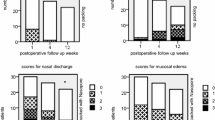Abstract
Purpose
This retrospective study assesses the risks and benefits linked to the non-use of nasal packing after a (rhino)septoplasty, compared with post-operative care with anterior nasal packing such as Merocel®.
Methods
Complication rates observed during the first week after surgery were compared between groups with and without use of classic nasal packing over a large sample of 534 patients, who had undergone either a closed or open procedure, with bilateral turbinoplasty, and with or without osteotomies. Complications listed include epistaxis, haematoma, impetiginization, septal perforation, hyperalgesia, and dyspnoea.
Results
No significant difference was observed between the group with and without packing regarding the immediate post-operative complications of epistaxis (4.4% of the cases with nasal packing versus 3% without, p = 0.918) and impetiginization (3% of the cases with nasal packing versus 4.2% without, p = 0.478). The technique used, as well as any osteotomies performed, had no impact on the results.
Conclusion
Non-use of nasal packing after a (rhino)septoplasty is a safe alternative to classic post-operative methods. Provided that there is a rigorous surgical technique and strict clinical control, it should be used as a principal technique in any routine practice due to its safety for patients immediately post-surgery.

Similar content being viewed by others
References
Hinderer KH (1971) History of septoplasty. Fundamentals of Anatomy and Surgery of the Nose. Aesculapis Publishing, Birmingham, pp 1–3
Cukurova I, Cetinkaya EA, Mercan GC, Demirhan E, Gumussoy M et al (2012) Retrospective analysis of 697 septoplasty surgery cases: packing versus trans-septal suturing method. Acta Otorhinolaryngologica Italica: Organo Ufficiale Della Societa Italiana Di Otorinolaringologia E Chirurgia Cervico-Facciale 32(2):111–114
von Schoenberg M, Robinson P, Ryan R et al (1993) Nasal packing after routine nasal surgery—is it justified? J Laryngol Otolo 107(10): 902–905
Kaur J, Singh M, Kaur I, Singh A, Goyal S et al (2018) A comparative study of gloved versus ungloved merocel® as nasal pack after septoplasty. Niger J Clin Pract 21(11):1391–1395. https://doi.org/10.4103/njcp.njcp_414_17
Wang YP, Wang MC, Chen YC, Leu YS, Lin HC, Lee KS (2011) The effects of Vaseline gauze strip, Merocel, and Nasopore on the formation of synechiae and excessive granulation tissue in the middle meatus and the incidence of major post-operative bleeding after endoscopic sinus surgery. J Chin Med Assoc 74:16–21
Kang, B, Jeong-Rok K, Jae-Min S, Il-Ho P, Heung-Man L, et al. (2017) Efficacy and safety of guardcel nasal packing after endoscopic sinus surgery: a prospective, single-blind, randomized controlled study. Clin Exp Otorhinolaryngol 10(3): 248–253. https://doi.org/10.21053/ceo.20160.01081.
Romano A, Salzano G, Dell’Aversana Orabona G, Cama A, Petrocelli M, Piombino P, Schonauer F, Iaconetta G, Salzano FA, Califano L (2017) Comparative study between biodegradable nasopore (BNP) and Merocel hemox 10 cm after septo-turbinoplasty procedure. Eur Rev Med Pharmacol Sci 21(4):669–673
Lemmens W, Lemkens P (2001) Septal suturing following nasal septoplasty, a valid alternative for nasal packing? Acta Otorhinolaryngol Belg 55(3):215–221
Naghibzadeh B, Ali AP, Ghazal N et al (2011) Does post septoplasty nasal packing reduce complications? Acta Med Iran 49(1):9–12
Certal V, Silva H, Santos T, Correia A, Carvalho C (2012) Trans-septal suturing technique in septoplasty: a systematic review and meta-analysis. Rhinology 50(3):236–245. https://doi.org/10.4193/Rhino120.051
Eşki E, Işıl AG, Evren H, Ismail Y, et al. (2014) Effects of nasal pack use on surgical success in septoplasty. Kulak burun bogaz ihtisas dergisi: KBB. J Ear Nose Throat 24(4): 206–210. https://doi.org/10.5606/kbbihtisas.2014.82160.
Jung YG, Ji WH, Young-Gyu E, Myung-Gu K et al (2011) Objective usefulness of thin silastic septal splints after septal surgery. Am J Rhinol Allergy 25(3):182–185. https://doi.org/10.2500/ajra.2011.25.3584
Deniz M, Zafer Ç, Aklime I, Oral BD, Erdoğan G et al (2014) The impact of different nasal packings on post-operative complications. Am J Otolaryngol 35(5):554–557
Bingol F, Ali B, Eda S, Korhan K, Buket OB et al (2017) Comparison of early-period results of nasal splint and merocel nasal packs in septoplasty. Turk Otolarengol Arsivi/Turk Arch Otolaryngol 55(3):136–139. https://doi.org/10.5152/tao.2017.2259
Yazici ZM, Sayin I, Erdim I, Gunes S, Kayhan FT, et al (2015) The effect of tobacco smoking on septoplasty outcomes: a prospective controlled study. Hippokratia 19(3)
Kim JS, Sam HK (2017) Is nonabsorbable nasal packing after septoplasty essential? A meta-analysis. Laryngoscope 127(5):1026–1031. https://doi.org/10.1002/lary.26436
Dąbrowska-Bień J, Piotr HS, Iwonna G, Katarzyna Ł, Henryk S et al (2018) Complications in Septoplasty Based on a Large Group of 5639 Patients. Eur Arch Oto Rhino Laryngol 275(7):1789–1794. https://doi.org/10.1007/s00405-018-4990-8
Chen X, Zhaohui S, **aoyuan L, Boyi S, Tao X, Li Q, Fuquan C et al (2015) Comparative study on packing with or without Merocel after endoscopic sinus surgery. Zhonghua Er Bi Yan Hou Tou **g Wai Ke Za Zhi Chin J Otorhinolaryngol Head Neck Surg 50(10):854–857. https://doi.org/10.1016/j.amjoto.20140.040.001
Funding
No financial disclosure.
Author information
Authors and Affiliations
Corresponding author
Ethics declarations
Conflict of interest
All authors certify that they have no affiliations with or involvement in any organization or entity with any financial interest or non-financial interest in the subject matter or materials discussed in this manuscript.
Ethics approval
Ethics approval was waived by the local Ethics Committee within the clinic (CSPO) in view of the retrospective nature of the study for procedures being part of routine care with guaranteed anonymity of data. All procedures performed in this study were in accordance with the 1964 Helsinki Declaration and its later amendments.
Additional information
Publisher's Note
Springer Nature remains neutral with regard to jurisdictional claims in published maps and institutional affiliations.
Rights and permissions
About this article
Cite this article
Seghers, N., Ledeghen, S., Collet, S. et al. Safety of (rhino)septoplasty without nasal packing in routine ENT practice. Eur Arch Otorhinolaryngol 278, 4329–4333 (2021). https://doi.org/10.1007/s00405-021-06713-9
Received:
Accepted:
Published:
Issue Date:
DOI: https://doi.org/10.1007/s00405-021-06713-9




